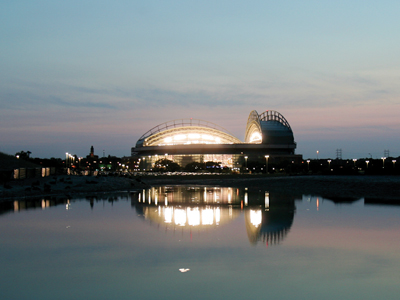



 |
   |
Hydraulics Facilitate Repairs on 12000 Ton Movable Roof

Irene Kremer, Enerpac
BV,
The day after the Milwaukee Brewers finished their final game of the season at Miller Park in September 2006, a different team went into action. This time the coaches were engineers, and the first-string players were millwrights, ironworkers, operating engineers, and laborers. The task for which they had been preparing was a major repair job on
the stadium's movable roof: replacement of the ten bogies (powered carriages)
on which the five movable sections of the roof are carried. The 12.000 t
roof is designed in a fan-shape, with each of five movable sections pivoted
at its home-plate end and riding on two bogies at its wide (outfield) end
183 m away. The 6,7 m long original-equipment bogies, two at each of the far corners of each fan-shaped roof section, were fitted with pairs of double-flanged wheels to ride on an 20 cm wide circular track approximately 42 m above ground level. Three-phase power for the bogie drive motors is fed out along each roof section from the home plate pivot end, eliminating any need for sliding contacts.
"The problem was in the cylindrical wheel with a relatively wide bearing surface where the outside of the wheel wanted to travel farther than the inside, about 140 mm in the worst case. It was this anomaly that may have caused the snapping sound as the bogies rolled along the rail," explains the consulting engineer responsible for specifying the jacking arrangements. "The wheels on the new bogies have spherical rolling surfaces, to allow for minor bogie tilt, and the wheel axles are turned such that the bogie naturally follows the curved track. Additionally, the new bogie design employs four wheels arranged in two pairs, instead of the previous two-wheel design."
Raising the roof
The stadium roof sections were jacked in ten separate lifts, one for each bogie replacement. Each time, the roof was lifted 102 - 152 mm, the old bogie driven out under its own power, a new bogie rolled in, and the roof lowered back into place on a spindle bearing. A 500 t crane moved bogies to and from ground level. Hydraulics provide lifting muscle The jacks were equipped with lock rings to guarantee load holding, and a locking valve was used in the pump-to-manifold feed line. The locking valve incorporates a check valve with a manually controlled pilot operator.
The bottom line Miller Park hosts a lot of loyal fans, and a 2005 Sports Illustrated
fan survey rated it as the best ballpark based on value per dollar spent.
Stadium officials are proud that not one of the more than 550 events held
during its six-year history has been cancelled because of weather, so they
are understandably pleased at the prospect of a much more reliably operating
roof.
|
|
© InfraStructures - Tous droits réservés - All rights reserved |